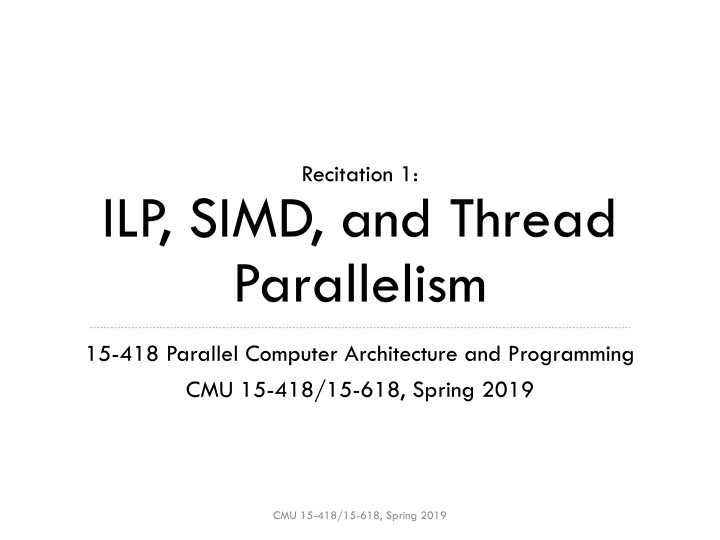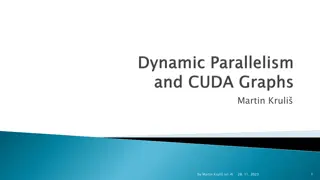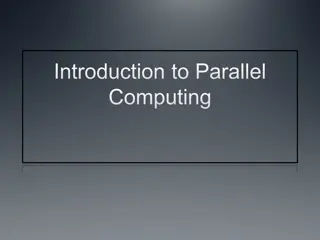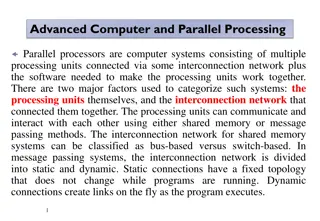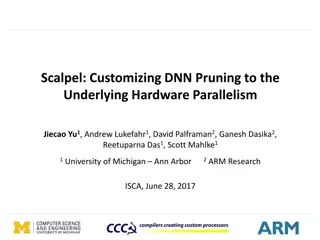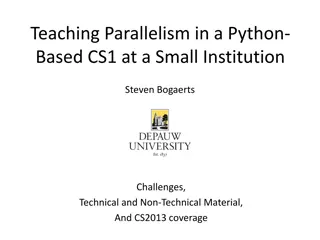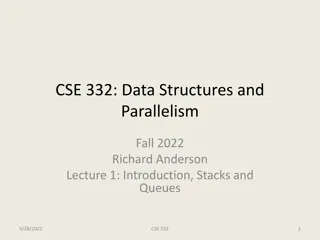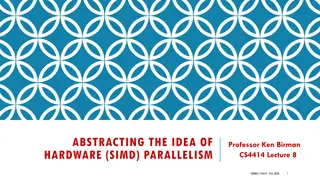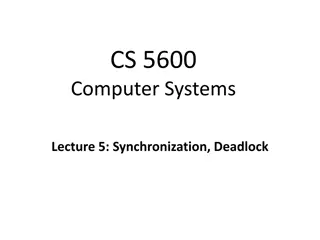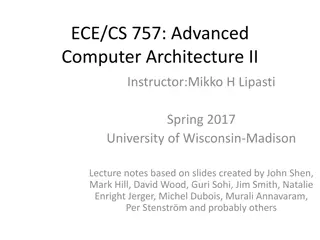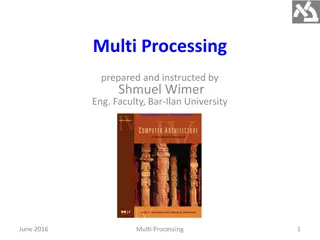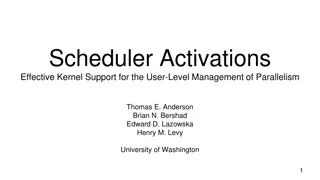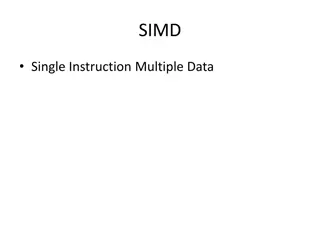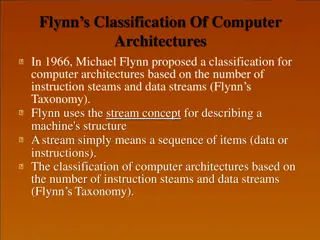ILP, SIMD, and Thread Parallelism
In this context, we delve into parallelism models such as ILP, SIMD, and threading, focusing on code optimization through example problems and solutions. The discussion involves a Taylor expansion of sin(x) code and identifies bottlenecks for optimization efforts. Techniques like loop unrolling and vectorization are explored to enhance program efficiency.
Uploaded on Feb 16, 2025 | 0 Views
Download Presentation

Please find below an Image/Link to download the presentation.
The content on the website is provided AS IS for your information and personal use only. It may not be sold, licensed, or shared on other websites without obtaining consent from the author.If you encounter any issues during the download, it is possible that the publisher has removed the file from their server.
You are allowed to download the files provided on this website for personal or commercial use, subject to the condition that they are used lawfully. All files are the property of their respective owners.
The content on the website is provided AS IS for your information and personal use only. It may not be sold, licensed, or shared on other websites without obtaining consent from the author.
E N D
Presentation Transcript
Recitation 1: ILP, SIMD, and Thread Parallelism 15-418 Parallel Computer Architecture and Programming CMU 15-418/15-618, Spring 2019 CMU 15-418/15-618, Spring 2019
Goals for today Topic is parallelism models: ILP, SIMD, threading Solve some exam-style problems Walk through example code Most of all, ANSWER YOUR QUESTIONS! CMU 15-418/15-618, Spring 2019
Recall: Taylor expansion of sin(?) How fast is this code? void sinx(int N, int terms, float * x, float *result) { for (int i=0; i<N; i++) { float value = x[i]; float numer = x[i]*x[i]*x[i]; int denom = 6; // 3! int sign = -1; Where should we focus optimization efforts? for (int j=1; j<=terms; j++) { value += sign * numer / denom; numer *= x[i] * x[i]; denom *= (2*j+2) * (2*j+3); sign *= -1; } What is the bottleneck? result[i] = value; } } CMU 15-418/15-618, Spring 2019
Recall: Taylor expansion of sin(?) How fast is this code? void sinx(int N, int terms, float * x, float *result) { for (int i=0; i<N; i++) { float value = x[i]; float numer = x[i]*x[i]*x[i]; int denom = 6; // 3! int sign = -1; On ghc machines: 7.2 ns / element 23 cycles / element for (int j=1; j<=terms; j++) { value += sign * numer / denom; numer *= x[i] * x[i]; denom *= (2*j+2) * (2*j+3); sign *= -1; } Not very good result[i] = value; } } CMU 15-418/15-618, Spring 2019
Recall: Taylor expansion of sin(?) Where should we focus optimization efforts? void sinx(int N, int terms, float * x, float *result) { for (int i=0; i<N; i++) { float value = x[i]; float numer = x[i]*x[i]*x[i]; int denom = 6; // 3! int sign = -1; for (int j=1; j<=terms; j++) { value += sign * numer / denom; numer *= x[i] * x[i]; denom *= (2*j+2) * (2*j+3); sign *= -1; } A: Where most of the time is spent result[i] = value; } } CMU 15-418/15-618, Spring 2019
Recall: Taylor expansion of sin(?) What is the bottleneck? void sinx(int N, int terms, float * x, float *result) { for (int i=0; i<N; i++) { float value = x[i]; float numer = x[i]*x[i]*x[i]; int denom = 6; // 3! int sign = -1; for (int j=1; j<=terms; j++) { value += sign * numer / denom; numer *= x[i] * x[i]; denom *= (2*j+2) * (2*j+3); sign *= -1; } result[i] = value; } } CMU 15-418/15-618, Spring 2019
Dataflow for a single iteration j j value value denom denom sign sign numer numer x[ x[i i] ] 2 2 LD 3 3 1 1 - -1 1 + + + + value value denom denom j j sign sign numer numer OK, but how does this perform on a real machine? CMU 15-418/15-618, Spring 2019
Superscalar OOO Processor What in microarchitecture should we worry about? CPU Instruction Buffer Commit Decode Fetch Execute Execute Execute Commit Fetch Decode In-order Out-of-order In-order CMU 15-418/15-618, Spring 2019
GHC Machine Microarchitecture What in microarchitecture should we worry about? NO. Any reasonable machine will have sufficient frontend throughput to keep execution busy + all branches in this code are easy to predict (not always the case!). Fetch & Decode? Execution? YES. This is where dataflow + most structural hazards will limit our performance. NO. Again, any reasonable machine will have sufficient commit throughput to keep execution busy. Commit? CMU 15-418/15-618, Spring 2019
Intel Broadwell (GHC machines) Execution Microarchitecture Integer Floating Point Latency Pipelined? Number Latency Pipelined? Number Add 1 4 3 1 Multiply 3 1 5 3 2 Divide 3-30 1 3-15 1 Load 1 2 CMU 15-418/15-618, Spring 2019
What is our throughput bound? j j value value denom denom sign sign numer numer x[ x[i i] ] 2 2 LD 3 3 1 1 - -1 1 + + + Op # Code ?Arch Thput bound + Int Add 3 4 0.75 value value denom denom j j sign sign numer numer Int Mul 4 1 4 Int Div 0 1 - FP Add 1 1 1 FP Mul 3 2 1.5 FP Div 1 1 3-15 Load 1 2 0.5
What is our latency bound? Find the critical path in the dataflow graph j j value value denom denom sign sign numer numer x[ x[i i] ] 2 2 LD 3 3 1 1 - -1 1 + + + + value value denom denom j j sign sign numer numer 3+(3/15)+3 =9 to 21 1 3 3+1+3+3=10 1+3+3=7
Takeaways Observe performance of 23 cycles / element Latency bound dominates throughput bound We are latency bound! Notes This analysis can often be eyeballed w/out full dataflow Actual execution is more complicated, but latency/thput bounds are good approximation (Also, avoid division!!!) CMU 15-418/15-618, Spring 2019
Speeding up sin(?): Attempt #1 What if we eliminate unnecessary work? void sinx_better(int N, int terms, float * x, float *result) { for (int i=0; i<N; i++) { float value = x[i]; float x2 = x[i]*x[i]; float numer = x2*x[i]; int denom = 6; // 3! int sign = -1; 6ns / element 18 cycles / element A: Small improvement. for (int j=1; j<=terms; j++) { value += sign * numer / denom; numer *= x2; denom *= (2*j+2) * (2*j+3); sign = -sign; } Why not better? result[i] = value; } } CMU 15-418/15-618, Spring 2019
What is our latency bound? Find the critical path in the dataflow graph j j value value denom denom sign sign numer numer x2 x2 2 2 3 3 1 1 + + + NEG + value value denom denom j j sign sign numer numer 3+(3/15)+3 =9 to 21 1 1 3 3+1+3+3=10
Attempt #1 Takeaways First attempt didn t change latency bound To get real speedup, we need to focus on the performance bottleneck Q: Why did we get any speedup at all? A: Actual dynamic scheduling is complicated; would need to simulate execution in more detail CMU 15-418/15-618, Spring 2019
Speeding up sin(?): Attempt #2 Let s focus on that pesky division void sinx_predenom(int N, int terms, float * x, float *result) { float rdenom[MAXTERMS]; int denom = 6; for (int j = 1; j <= terms; j++) { rdenom[j] = 1.0/denom; denom *= (2*j+2) * (2*j+3); } for (int i=0; i<N; i++) { float value = x[i]; float x2 = value * value; float numer = x2 * value; int sign = -1; for (int j=1; j<=terms; j++) { value += sign * numer * rdenom[j]; numer *= x2; sign = -sign; } result[i] = value; } } A: Big improvement! 2.4ns / element 7.7 cycles / element CMU 15-418/15-618, Spring 2019
What is our latency bound? Find the critical path in the dataflow graph value value rdenom rdenom[j] [j] j j sign sign numer numer x2 x2 LD 1 1 + NEG + & value value j j sign sign numer numer 3+3=6 1 1 3
Attempt #2 Takeaways Here we go! Attacking the bottleneck got nearly 3 ! But performance is still near the latency bound, can we do better? CMU 15-418/15-618, Spring 2019
Speeding up sin(?): Attempt #3 Don t need sign in inner-loop either void sinx_predenoms(int N, int terms, float * x, float *result) { float rdenom[MAXTERMS]; int denom = 6; float sign = -1.0; for (int j = 1; j <= terms; j++) { rdenom[j] = sign/denom; denom *= (2*j+2) * (2*j+3); sign = -sign; } for (int i=0; i<N; i++) { float value = x[i]; float x2 = value * value; float numer = x2 * value; for (int j=1; j<=terms; j++) { value += numer * rdenom[j]; numer *= x2; } result[i] = value; } } 1.1ns / element 3.5 cycles / element CMU 15-418/15-618, Spring 2019
What is our latency bound? Find the critical path in the dataflow graph value value rdenom rdenom[j] [j] j j numer numer x2 x2 LD 1 1 + LATENCY BOUND! LATENCY BOUND! + & value value j j numer numer 3 (LD will be executed speculatively, only depends on j) 1 3
Attempt #3 Takeaways We re down to the latency of a single, fast operation per iteration + Observed performance is very close to this latency bound, so throughput isn t limiting We re done optimizing individual iterations How to optimize multiple iterations? Eliminate dependence chains across iterations A) Loop unrolling (ILP) B) Explicit parallelism (SIMD, threading) CMU 15-418/15-618, Spring 2019
Speeding up sin(?): Loop unrolling Compute multiple elements per iteration void sinx_unrollx2(int N, int terms, float * x, float *result) { // same predom stuff as before for (int i=0; i<N; i++) { float value = x[i]; float x2 = value * value; float x4 = x2 * x2; float numer = x2 * value; for (int j=1; j<=terms; j+=2) { value += numer * rdenom[j]; value += numer * x2 * redom[j+1]; numer *= x4; } result[i] = value; } } Correct? Not yet CMU 15-418/15-618, Spring 2019
Speeding up sin(?): Loop unrolling Compute multiple elements per iteration void sinx_unrollx2(int N, int terms, float * x, float *result) { // same predom stuff as before for (int i=0; i<N; i++) { float value = x[i]; float x2 = value * value; float x4 = x2 * x2; float numer = x2 * value; int j; for (j=1; j<=terms-1; j+=2) { value += numer * rdenom[j]; value += numer * x2 * redom[j+1]; numer *= x4; } for (; j<=terms; j++) { value += numer * rdenom[j]; numer *= x2; } result[i] = value; } } 0.99 ns / element 3.2 cycles / element Didn t change CMU 15-418/15-618, Spring 2019
What is our latency bound? Find the critical path in the dataflow graph value value rdenom rdenom[j] [j] x2 x2 numer numer j j rdenom rdenom[j+1] [j+1] x4 x4 LD 2 LD + + & + & value value j j numer numer 6/2=3 (LD will be executed speculatively, only depends on j) 1/2=0.5 3/2=1.5
Speeding up sin(?): Loop unrolling #2 What if floating point associated + distributed? void sinx_unrollx2(int N, int terms, float * x, float *result) { // same predom stuff as before for (int i=0; i<N; i++) { float value = x[i]; float x2 = value * value; float x4 = x2 * x2; float numer = x2 * value; int j; for (j=1; j<=terms-1; j++) { value += numer * (rdenom[j] + x2 * redom[j+1]); numer *= x4; } for (; j<=terms; j++) { value += numer * rdenom[j]; numer *= x2; } result[i] = value; } } 0.69 ns / element 2.2 cycles / element CMU 15-418/15-618, Spring 2019
What is our latency bound? Find the critical path in the dataflow graph value value rdenom rdenom[j] [j] x2 x2 numer numer j j rdenom rdenom[j+1] [j+1] x4 x4 LD LD 2 + + & + & value value j j numer numer 3/2=1.5 (LD will be executed speculatively, only depends on j) 1/2=0.5 3/2=1.5
Loop unrolling takeaways Need to break dependencies across iterations to get speedup Unrolling by itself doesn t help We are now seeing throughput effects Latency bound = 1.5 vs. observed = 2.2 Can unroll loop 3x, 4x to improve further, but Diminishing returns (1.65 cycles / element at 4x) CMU 15-418/15-618, Spring 2019
Speeding up sin(?): Going parallel (explicitly) Use ISPC to vectorize the code export void sinx_reference(uniform int N, uniform int terms, uniform float x[], uniform float result[]) { foreach (i=0 ... N) { float value = x[i]; float numer = x[i]*x[i]*x[i]; uniform int denom = 6; // 3! uniform int sign = -1; for (uniform int j=1; j<=terms; j++) { value += sign * numer / denom; numer *= x[i] * x[i]; denom *= (2*j+2) * (2*j+3); sign *= -1; } 1.0 ns / element 3.2 cycles / element result[i] = value; } } CMU 15-418/15-618, Spring 2019
Speeding up sin(?): Going parallel (explicitly) + optimize export void sinx_unrollx2a(uniform int N, uniform int terms, uniform float x[], uniform float result[]) { uniform float rdenom[MAXTERMS]; uniform int denom = 6; uniform float sign = -1; for (uniform int j = 1; j <= terms; j++) { rdenom[j] = sign/denom; denom *= (2*j+2) * (2*j+3); sign = -sign; } foreach (i=0 ... N) { float value = x[i]; float x2 = value * value; float x4 = x2 * x2; float numer = x2 * value; uniform int j; for (j=1; j<=terms-1; j+=2) { value += numer * (rdenom[j] + x2 * rdenom[j+1]); numer *= x4; } for (; j <= terms; j++) { value += numer * rdenom[j]; numer *= x2; } result[i] = value; } 0.14 ns / element 0.45 cycles / element CMU 15-418/15-618, Spring 2019
SIMD takeaways Well, that was easy! (Thanks ISPC) Scalar Vector Unoptimized 23 3.2 Cycles per element: Unrolled 2.2 0.45 Speedup 7.2 Original Vector 51 10 7 Vector + Unrolled 4.9 Unrolled CMU 15-418/15-618, Spring 2019
What if? #1 Impact of structural hazards Q: What would happen to sin ? if we only had a single, unpipelined floating-point multiplier? A1: Performance will be much worse A2: We will hit throughput bound much earlier A3: Loop unrolling will help by reducing multiplies CMU 15-418/15-618, Spring 2019
What if? #2 Impact of structural hazards Q: What would happen to sin ? if LDs (cache hits) took 2 cycles instead of 1 cycle? A: Nothing. This program is latency bound, and LDs are not on the critical path. CMU 15-418/15-618, Spring 2019
Loads do not limit sin(?) Consider just the slice of the program that generates the subexpression: rdenom j + x2 rednom j + 1 rdenom rdenom[j] [j] x2 x2 rdenom rdenom[j+1] [j+1] j j 2 What is this program s latency + throughput bound? LD LD + + & j j subexp subexp Latency bound: 1 cycle / iteration! Through j computation, not the subexpression computation there is no cross-iteration dependence in the subexpression!) Throughput bound: also 1 cycle / iteration 1 add / 4 adders; 2 LDs / 2 LD units; 1 FP FMA / 1 FP unit (This will change to 2 cycles if we add the value FMA)
Loads do not limit sin(?): Visualization 0 2 Consider just the slice of the program that generates the subexpression: ( rdenom j + x2 rednom j + 1 Subexpressions are off the critical path + we have enough throughput to produce next subexpression each cycle (excluding value FMA) + LD + & subexp subexp j j 2 LD + LD ) j j subexp subexp + & 2 LD + LD + & j j subexp subexp 2 LD + LD + & subexp subexp 2 j j LD + LD + & subexp subexp j j LD CMU 15-418/15-618, Spring 2019
Loads do not limit sin(?): Example execution Note: Throughput limit is 2 cycles / iteration once we add value FMA, but this is dominated by the latency bound of 3 cycles / iteration (also from value FMA). Regardless, 2-cycle LDs are not the bottleneck. INT INT ADD ADD j=0 j=2 j=4 j=6 j=8 ... rdenom[0] rdenom[4] rdenom[8] ... LD1 LD1 rdenom[2] rdenom[6] ... rdenom[1] rdenom[5] rdenom[9] ... LD2 LD2 rdenom[3] rdenom[7] ... subexp value value value value FP FP FMA FMA subexp subexp subexp subexp numer =x^4 numer =x^8 numer =x^12 numer =x^16 numer =x^20 ... FP FP MUL MUL CMU 15-418/15-618, Spring 2019
What if? #3 Vector vs. multicore Q: What would happen to sin ? if the vector width was doubled? A1: If we re using ISPC, we would expect roughly 2 performance (slightly less would be realized in practice). Q: Can we do this forever & expect same results? A: No. Computing rdenom will limit gains (Amdahl s Law). Q: For this sin(?) program, would you prefer larger vector or more cores? A: Either should give speedup, but this program maps easily to SIMD, and adding vector lanes is much cheaper (area + energy) than adding cores. (Remember GPU vs CPU pictures.) CMU 15-418/15-618, Spring 2019
What if? #4 Benefits(?) of SMT Q: How should we schedule threads on a dual-core processor with SMT, running these two apps, each of which have 2 threads? The sin(?) function A program that is copying large amounts of data with very little computation (Note: There are four cores and four threads) A: We want to schedule one sin ? thread and one memcpy() thread on each core, since SMT is most beneficial when threads use different execution units CMU 15-418/15-618, Spring 2019
What if? #5 Limits of speculation Q: What will limit the performance of this (silly) program on a superscalar OOO processor? int foo() { int i = 0; while (i < 100000) { // assume single-cycle rand instruction if (rand() % 2 == 0) { i++; } else { i--; } } } A: Unpredictable branch in if-else will cause frequent pipeline flushes CMU 15-418/15-618, Spring 2019
What if? #6 Benefits(?) of SMT Q: Would the previous program benefit from running on multiple SMT threads on a single core? A: Yes! Its performance is limited by the CPU frontend, which is replicated in SMT CMU 15-418/15-618, Spring 2019
